Alex Herrera says extreme attention to detail and an overclocked Core i7 CPU make this a powerhouse for the most demanding CAD and DCC applications.
By Alex Herrera
Opening the chassis on any Boxx workstation is a diversion from the mundane, because Boxx designs anything but ordinary machines. The company knows that to compete with the big-volume boys, it must differentiate as much as possible. And once again, in the case of the 4920 Xtreme, Boxx takes some noteworthy slants on workstation design, most notably—but not limited to—its liquid-cooled CPU.
|
|
Component |
| CPU |
Intel Core i7-3960X Extreme hex-core, over-clocked and liquid-cooled to 4.5GHz |
| Memory |
6 GB of 1333 MHz DDR3 |
| Disk |
RevoDrive 240 GB SSD (PCI Express) |
| Graphics |
Nvidia Quadro 5000 with 2.5 GB Nvidia Quadro 600 with 1 GB |
| OS |
Windows 7 Professional |
| MSRP |
$3,198 (base) $7,463 (as configured, with Quadro 5000) $5,635 (as configured, with Quadro 600) |
Configuration specifications for our 4920 Xtreme review machine. (Source: Jon Peddie Research)
This machine came configured with virtually every possible hardware tool imaginable to maximize performance: the top-of-the-line Westmere-generation, hex-core Core i7 CPU, liquid-cooled to an impressive 4.5 GHz; the ultra-high end Nvidia Quadro 5000 GPU; 16 GB of 1600 MHz DDR3 memory; and topping it all off, a PCI Express-resident 240 GB Solid State Drive (SSD). Clearly, Boxx left no stone unturned when it came to outfitting a high-performance workstation.

Aesthetics and ergonomics
With OEMs looking for every possible way to differentiate, and with Apple’s obvious success due at least in part to marketing style, aesthetics is no longer overlooked when it comes to workstation design.
Workstation OEMs have been borrowing a page from Apple’s playbook lately, leaning toward the beefy, industrial look, showing grill work and—cost allowing—more metal than plastic. That emphasis goes double for vendors and models focused on the digital content creation (DCC) markets. Boxx is one such vendor, and it is winning business by being the price leader, so it can afford to spend a bit more on the metal, exemplified by the company’s burly, signature 1/8th inch alloy plate fastened securely to the enclosure’s top.
Offering plentiful I/O with the right subset cleanly accessible isn’t just a nicety. It’s mandatory, perhaps especially so in digital content creation environments which demand connectivity to a broad range of media devices. And again, as a premium vendor marketing premium products, Boxx can’t cut corners on I/O. For a machine priced like the 4920 Xtreme, there simply can’t be anything missing.
Accordingly, it would be hard for anyone to take issue with the 4920 Xtreme’s offerings. The front panel offers the easily accessible, with four USB ports, audio mic in, and mini-jack stereo, along with one 1394 port. And the rear panel offers the plentiful, with two Gigabit Ethernet ports, one 1394 and eight USB ports, two external SATA ports to expand storage, and the full breadth of audio I/O, including S/PDIF optical output, analog line-in, and full 7.1 analog audio out. Even the old PS/2 style keyboard and mouse connectors find a home on the 4920’s backside. We are always surprised when we hear OEMs tell us customers still ask for PS/2 ports … but they do.
That’s a total of 10 USB ports, and we’re not just talking USB 2.0. Notice how four of them are color-coded blue? Those are the über-bandwidth, SuperSpeed USB 3.0 ports. Not supported in the native Intel platform when the 4920 was being spec’d, Boxx had to populate an extra chip (NEC, perhaps) on the motherboard to offer 3.0.
Now, if you count up all those USB ports in the rear, you’re going to find one extra, sitting next to a recessed press-button named “USB BIOS Flashback.” In case you’re not familiar, the name says it all. Available on Asus X79 motherboards, Flashback allows an easy external update of the BIOS. Simply plug in the flash drive with new firmware in the root directory and hit the paired button. A light will flash as the update is in process, turning off to signal the “flashback” is complete.
Many, including us, tend to be guilty of giving audio short shrift, with graphics and video getting all the attention when it comes to media capabilities. But, as anyone can readily imagine, any premium workstation marketed to the studio and content creation markets has to be up to snuff when it comes to audio as well. And with digital audio out, line in and full 7.1 channels on the motherboard (2 x front, center, 4 x rear and subwoofer), the 4920 Xtreme covers all the bases, audio bases most workstations would require an optional card to meet.
Running counter to big OEMs’ offerings, less attention to being tool-less
Over recent years, big-name workstation OEMs have been highlighting tool-less hardware maintenance to differentiate their wares from the competition. The convenience of opening up the chassis, installing video cards, swapping drives or even power supplies without so much as a screwdriver is no doubt an appealing feature, assuming that no compromises are made in function and durability.
To the average user, tool-less might seem a bit gimmicky. After all, how often do you really have to get inside the chassis? For those few times, it’s hardly a chore to grab a Philips-head screwdriver and make a few twists here and there. But as an analyst, who’s constantly in and out of a machine I’m reviewing, I have to say I do appreciate tool-less, even if the screwdriver is always at the ready. I can certainly appreciate an IT manager of a large design group thinking the same.
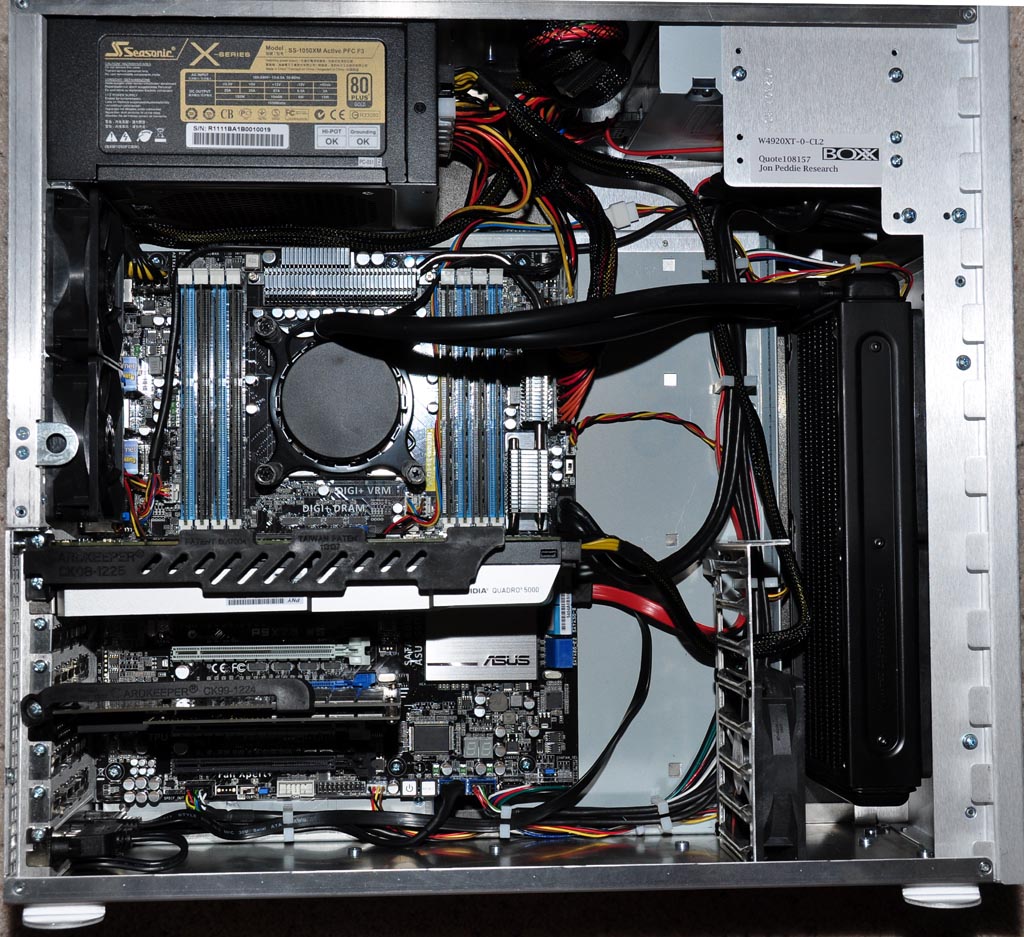
So how does Boxx approach the idea of tool-less? Well, to simply match what other OEMs are doing wouldn’t serve Boxx’s aim of differentiation. The company recognizes that some tool-less options can sacrifice reliability, and—to be blunt—often look cheap and flimsy. So when putting together a water-cooled, no-compromise performance machine with unquestioned reliability, a weak, me-too solution for access and retention isn’t going to cut it.
So no, like the 4850 Extreme before it, the 4920 Xtreme isn’t tool-less. But again, it’s no particular chore to service, and unless you foresee some reason that frequent access is a must; honestly it’s no big deal. A twist of thumbscrews opens the side panel, and swapping a video card can be accomplished with removal of two Philips-head screws on a burly retention bracket that grips the card’s edge. Tool-less is nice, but if it meant Boxx would have to compromise on burliness, then it certainly made the right choice, as this machine—unlike others—will often house $1,500+ video cards (like our Quadro 5000) that you really want solidly fastened.
Liquid-cooling makes the ultra-fast clock achievable … but you’ve got to have the Watts to drive it
When you can tout an exotic water-cooled motherboard, do you really need to be worrying about a screw here or there? Like we’ve said many times, credit Boxx for doing in workstations what others haven’t. The 4920 Xtreme is one of the few branded workstations with an overclocked, water-cooled CPU. It’s the second we’ve tested, with the first not surprisingly also coming from Boxx.
Eighteen months ago, we had our first encounter with a liquid-cooled workstation, when we reviewed a predecessor of the 4920 Xtreme, the 4850 Extreme (somewhere along the line, Boxx dropped the “E”). Where the 4850’s liquid-cooling came from CoolIT, the 4920’s comes from the other premier name—and we assume the highest-volume supplier—Asetek.
Asetek’s system was the first thing that caught our eye when opening up the 4920 Xtreme. The liquid-cooling isn’t there just for show, but to allow Intel’s Core i7 CPU to be cranked up to 4.5 GHz (as compared to the 3.3 GHz nominal (i.e. non-Turbo) frequency, where Intel’s standard specs top out). While the clear trend in processor design is multi-core, remember that the degree to which applications can take advantage of multiple cores varies. And sometimes, faster, fewer cores deliver the goods more than slower, more plentiful cores can. It’s a premise we explore in benchmarking further ahead.
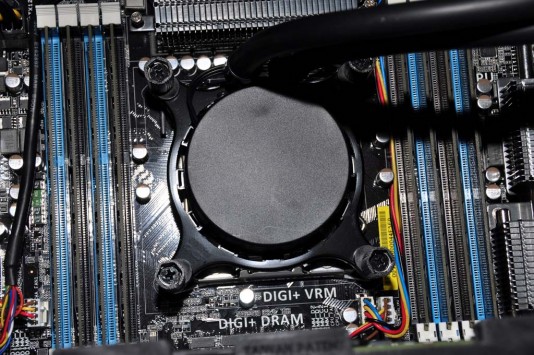
Now, the idea behind any thermal dissipation scheme, be it a car or a workstation, is to transfer the heat from where it’s produced, and where it could interfere with system operation, to some other place where it won’t. In a car, coolant circulates through the engine and then to the radiator which transfers the heat to incoming cooler air. Well, the principle behind computer system liquid-cooling isn’t very different, though the implementation sure is.

Asetek’s system circulates liquid coolant from the CPU to a radiator on the system’s front grill. Two fans pull in outside air to cool the liquid which in turn cools the CPU. Two rear fans complement the front to help push air back out, creating enough airflow to cool the rest of the systems’ components that don’t have the benefit of liquid-cooling.
But of course in today’s workstation market, noise levels can matter just as much as performance. And with an SSD-outfitted machine, all of the noise is a function of airflow, both in terms of how much air is being moved and what obstacles that air confronts along the way. Little things like awkward air routing or dangling power or SATA cables will make a difference, hence the tidy interior of the 4920 Xtreme.
Still, dialing down decibels is mostly about dialing down fans. So while the coolest solution would be to run all the fans maxed out all the time, it clearly is not the quietest (nor the most reliable or cheapest to operate, for that matter). Accordingly, Boxx designed the 4920 Xtreme to dynamically adjust the air flow both through the front radiator as well as the out-bound fans in the rear. A thermal couple in the rear measures the exiting air and cranks up the out-bound fans if and when necessary. Similarly, a monitor embedded in the liquid cooling system tracks coolant temperature and dials up (or down) the intake radiator fans’ speed accordingly.
Boxx never skimps on slots and bays
Following Boxx and reviewing their products, a consistent theme quickly emerges: differentiate noticeably and often. We know of no other, moderate-or-better volume workstation vendor that designs in as many expansion slots and drive bays as Boxx. It’s become a signature for the company, one of a few reasons we’d feel confident identifying a Boxx machine by the inside views alone.
Like the 4850 before it, this workstation stands out from most competitors (particularly in the single-socket realm) for the number of graphics-capable x16 (mechanical) PCI Express slots it houses: six in all. More slots mean more monitors and more display space, and that’s been the primary driver for OEMs to support more than one card. More recently, the demand for GPU computing—in which an auxiliary I/O-less GPU sits in an x16 slot—has grown in workstation segments, including the CAD and DCC spaces. Applications like raytracing, computational fluid dynamics and finite element analysis lend themselves well to highly-parallel, FLOP-heavy, architectures like the modern GPU’s.
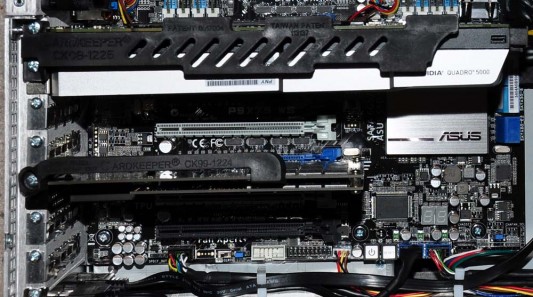
Intel’s chipsets have slowly but surely complied, and now two x16 PCI Express slots is pretty much the norm in the workstation space. With the previous generation’s 4850 Extreme, Intel’s X58 chipset couldn’t quite supply enough PCI Express lanes to support all those x16 links (even if some had x8 or x4 electrical interfaces “underneath”). So Asus motherboard designers at the time went to the trouble of soldering down an additional PCI Express bridge device to serve 4850’s array of slots.
But this time around, that wasn’t necessary. When Intel moved to the Westmere generation, it began integrating PCI Express into the CPU. And this motherboard combined the Westmere CPU’s 40 PCI Express lanes with the X79 chipset’s 8 to allow all six x16 (mechanical) slots to function without the extra bridge.
A quick run of the math, and it’s obvious not all of those six x16’s (64) can get fully driven by 48 lanes, so Boxx has to make some tradeoffs. Two of the six are fixed at x8 electrical (color coded black), and two are fixed at x4 electrical (color coded gray), which means they can provide 50% to 25% of maximum PCI Express 2.0 bandwidth. Now, for mainstream graphics use, x8 will suffice, and for everything else, x4 will be good enough. But this is not a mainstream machine, and its users aren’t running mainstream applications.
As such, the Asus and Boxx engineers allocated the full 16-wide links for the remaining two x16’s (color coded blue), but under the condition that the black x8 slots are not fully occupied. If one of the black slots is filled, then one of the blue x16s automatically down-scales to x8. Ditto for the other one. A reasonable solution: all lanes get used, the system can support six cards, but in the more common case of just two, they get the full bandwidth possible.
Sourcing the Watts to drive all those performance components
With a 4.5 GHz CPU to supply with power, along with 8 DIMMs of fast DDR3 DRAM and up to (in theory) six graphics add-in cards, the 4920 design team couldn’t just pull any old power supply off the shelf. A premium, high-wattage workstation needs a premium, high-wattage supply, and—as has been the case in past models—Boxx once again complies.
Rather than the power supply from Zalman we encountered last time around, this time we find a Seasonic X-series, “80 Plus Gold” unit capable of an aggregate 1050 Watts. That’s a hefty total, more than enough to handle most possible configurations that would stifle most of the 4920’s single-socket peers. For example, housing two Quadro 5000s are in reach of the Boxx’s 4920, a capability limited to dual-socket models in other vendors’ workstation lines.
Ironically, engineers looking at power reduction often spend an inordinate amount of time worrying about a milliamp of low-voltage current here or there, when inefficient power supplies were wasting 10’s or even 100’s of Watts … a case of guarding the cash drawer while the vault was being robbed.
But with the heavy emphasis these days on power consumption (to reduce bills, reduce heat and reduce cooling noise), designers are paying close attention to power supply efficiency. And the X-Series 80 Plus Gold rating means this one is highly efficient, turning over 87% of input AC line power into output power across the usual range of DC voltages (+5V, 3.5V, +12V and -12V). That’s no easy task and pretty much hits the maximum efficiency we’ve seen in a workstation supply (though HP is now quoting 90% in the recent Z1 all-in-one model).
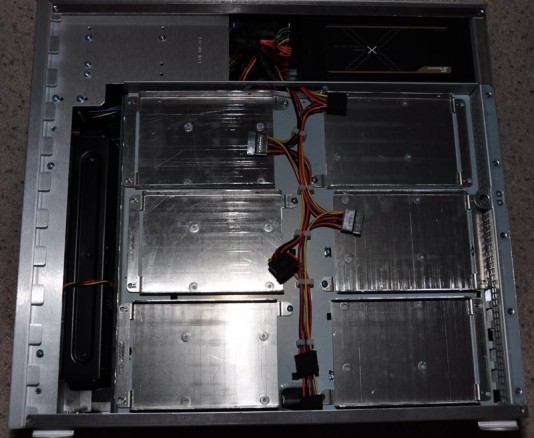
Spurn convention: an array of drive bays on the backside
Take a closer look back at that full interior photo of the 4920 Xtreme, and you might notice something missing. Where’s the ubiquitous rack of drive bays? No, they’re not there, because again Boxx spurned convention, and instead of stacking them in the corner of the main chassis interior, Boxx engineers created an entire separate mechanical partition, accessible from the opposite side panel. This is the same layout as we saw in the previous 4850 Xtreme, and we like it … easy to get at, easy to secure, and no fighting with cable lengths or getting fingers on SATA connectors.
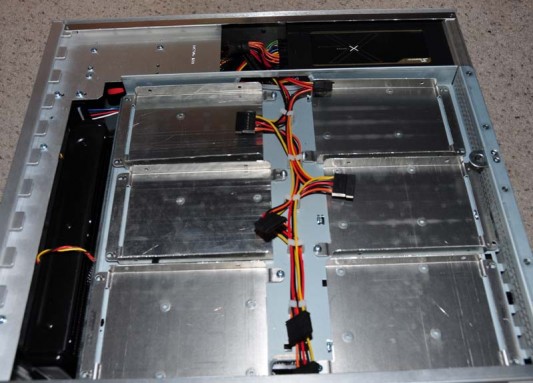
The bays are clean and easily accessible, which is no small feat when you’re designing in six bays, two more than most mid-range and high-end Xeon-class workstations provide. Boxx is always going to take the road less traveled, and the 4850 Extreme’s storage subsystem is no exception.
A max performance machine like this cries out for an SSD
It’s worth noting that we didn’t remove a drive from a bay before taking the picture. With our 4920 Xtreme’s configuration, all bays were empty. That’s because we didn’t have a hard-disk drive at all, but instead a high-speed RevoDrive3 X2 Solid State Drive (SSD), housed in one of the 4920’s six PCI Express slots.
We said from the beginning that Boxx left no stone unturned in its quest to create the highest performing system possible. That means balancing the system and removing bottlenecks that can occur in storage I/O, particularly with workflows that involve big, complex content (representative of Boxx’s user base). SSDs typically trade off dollars and capacity per drive to boost performance, both in terms of bandwidth, but also—and especially—in read latency. Without the slow seek time (and sometime very slow startup time) associated with heads over rotating media, the SSD is very fast loading new data, and bouncing around between different data, as is often the case running the OS.
Now, this SSD, sitting on PCI Express and coupled with an on-motherboard cache, not only helps with latency, it’s seriously maxing out bandwidth. Clearly, part of the machine’s solid performance on system-level benchmarks (see ahead) is certainly due to the prowess of the SSD. Again, it’s not a big drive; any configuration of this machine would want to see some big SATA drives populated to manage the volume of data most users will deal with.
And it’s by no means cheap; the price on Amazon.com for 240 GB was $655. At a quarter the size of a drive costing a sixth the price, you’re looking at around 25X the dollars/GB. But for some high-demand users, the cost of the SSD premium pales in comparison to the cost of impaired productivity. And the Boxx user contingent certainly contains many users who fit that description.
Now, we do have to report that our SSD failed during review. It got progressively flakier on boots, until it finally died (which extended our testing, as we hadn’t yet retrieved all our results from said drive, requiring us to retest everything … but that’s another story). The failure was ironic, considering that one of the selling points of an SSD is reliability (e.g. no mechanical parts).
Was it a fluke? We’d have to assume so, and Boxx’s replacement SSD worked just fine. But in our quick-and-dirty diagnosis, we did notice that the card did not sit so securely in the slot, in part due to the fact that its motherboard edge was only secured by the fingers of x4 mechanical insertion. The opposite edge does have the screw-on retention bar, but that doesn’t help the flex on the bottom. We don’t know if any movement of the card in the slot had anything to do with the failure, but it certainly seems like it should feel more secure than it does.
Benchmarking the 4920 Xtreme
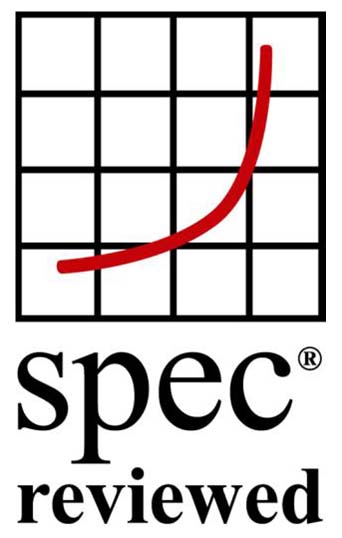 To assess the performance of Boxx’s 4920 Xtreme, we employed the same basic tools we have in the past. We tapped SPEC’s Viewperf to isolate the stress on the graphics cards, and we used SPECapc, Cadalyst and Cinebench tests to get a handle on how well the cards support whole-system performance for key verticals like Digital Content Creation (DCC) and CAD. Choosing among the SPECapc suite of benchmarks, we chose Lightwave and 3ds max, representing two popular applications used in those spaces.
To assess the performance of Boxx’s 4920 Xtreme, we employed the same basic tools we have in the past. We tapped SPEC’s Viewperf to isolate the stress on the graphics cards, and we used SPECapc, Cadalyst and Cinebench tests to get a handle on how well the cards support whole-system performance for key verticals like Digital Content Creation (DCC) and CAD. Choosing among the SPECapc suite of benchmarks, we chose Lightwave and 3ds max, representing two popular applications used in those spaces.
The latter was especially useful, as the latest version, SPECapc for 3ds max 2011 has been updated. Improvements include new models and test cases, a cleaner and enhanced user interface, and most importantly, compatibility with more recent versions of both 3ds max (2011) and Windows (both 32 and 64-bit Windows 7).
With the review of this Boxx machine, Jon Peddie Research submitted test results to SPEC through the “SPEC Reviewed” (http://www.spec.org/gwpg/specreviewed.html) program. Results for our benchmarking, as well as others submitted, can be seen at http://www.spec.org/benchmarks.html#gwpg.
Viewperf 11
First up was Viewperf 11, the most recent revision of the long-time graphics benchmark. A nice step up from Viewperf 10, this version thankfully does away with the multitude of confusing options on running the benchmark and in their place is a simple dialog box that allows you to select resolution and number of iterations. Quite simple; thank you, SPEC.
We separately installed both the ultra-high end Quadro 5000 and the entry Quadro 600, making sure to download the latest-and-greatest driver from Nvidia’s support site. Where 1280 x 1024 used to be a reasonable common denominator for setting resolution, we’re now pushing to 1920 x 1080, as the resolution is generally pervasive and supported by even the most modestly priced monitors. We ran Viewperf 11 on each card with three iterations.

No surprise at all, the Quadro 5000 beat out the Quadro 600 handily. Of course it should, as price and capability-wise, we’re talking apples and oranges. Both sets of scores are generally on par with scores we’ve witnessed in the past and seen submitted on SPEC.org. Now “on par” doesn’t
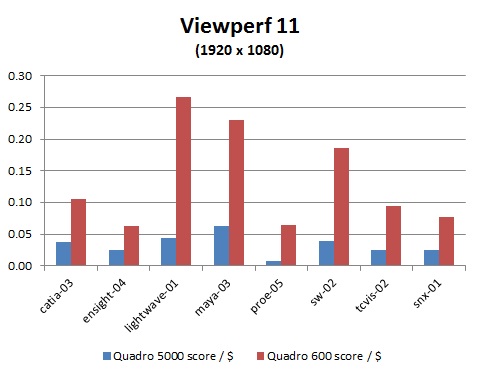
mean identical, and we ran up scores on the Quadro 5000 that more often than not beat other submitted scores for the same card. We attribute the modest improvement to more optimized drivers (ours was far more recent) and also to the speed of the 4920. While Viewperf does its best to isolate the stress on the video card, it will scale a tad with a faster CPU and other system components.
Comparing the two cards straight-up heavily favors the Quadro 5000, of course. But what about comparing the price/performance? If we weigh scores/$, the $170 (ASP) Quadro 600—at a tenth the price of the ~$1,750 Quadro 5000—comes out far ahead. Again, an expected result, as performance gains are never linearly commensurate with price. All in all, the Viewperf numbers reflect cards that each deliver about the best performance available at their respective prices.
SPECapc for Lightwave 9.6
Viewperf provides a revealing look, albeit a theoretical one, at the machine’s best-case graphics potential. But theoretical and best-case are generally less interesting than practical and typical-case. To evaluate overall system performance, we employed two SPECapc tests, for 3ds max and Lightwave, along with Cadalyst 2011 and Cinebench. While 3ds max is increasingly used in CAD spaces like architecture, engineering and construction (AEC), both have primarily been used by digital content creators.
Now with SPECapc, neither the graphics nor the rest of the system are solely responsible for scores. Rather, it’s the sum of the parts that are being tested, with the goal of demonstrating how the system might perform in a real-world environment. Where GPU-accelerated rendering is the bottleneck, throughput will vary by graphics card. But where it’s not (CPU, memory or I/O limitations), the test won’t show a difference. Average it all out, and the results for different cards in the same system will show substantially smaller differences than they do for Viewperf.
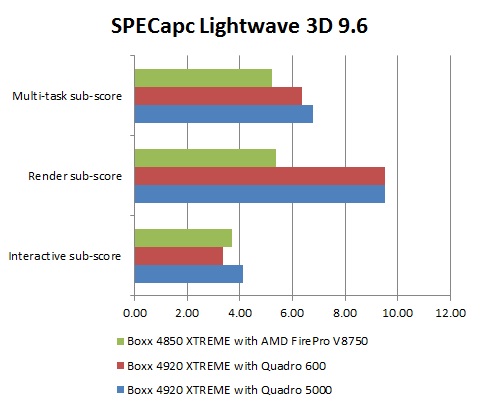
In the context of Lightwave, we were not only able to compare results for the 4920 Xtreme with both the Quadro 600 and Quadro 5000 installed, we were able to compare scores from the 4920’s predecessor, the 4850 Extreme. How does today’s version stand up to other high-end single-socket machines? And how much more performance has Boxx achieved in a similar build 18 months later?
First off, we’d expect a system-level benchmark that’s sensitive to CPU performance would look great on this machine, thanks to its outrageous 4.5 GHz clocking and supporting high-performance subsystems (e.g. SSD). And it does. The Render score of 9.53 blows away other numbers we’ve seen, more than doubling the results from other high end systems. It’s not quite double what the 4850 Extreme delivered 18 months prior, but it is pretty close. That alone is a great example of Moore’s Law in operation, justifying why professionals (or their IT departments) need to constantly be reevaluating the ROI proposition of investing in new hardware.
Looking next at the performance of the Quadro 600 versus the 5000, one might be tempted to quickly conclude that there’s no point in spending a lot more on the 5000, not when the 600 does nearly as well, even at equality for the image “Render” portion. Now, that parity needs to be taken in context and with a big grain of salt. First off, SPECapc Lightwave is far more CPU-bound than many benchmarks, especially for the Render and Multi-task sub-tests of Lightwave. Second, though the Render component might conjure up notions of heavy, GPU-sensitive processing, in this case rendering is performed in software on the CPU, not via GPU-accelerated APIs like OpenGL or DirectX). So read in context, the results don’t yield any unexpected conclusions.

Running SPEC’s latest revision of its SPECapc suite—that for 3ds max—is a pleasure, compared to many previous benchmarks, from SPECapc and others. The interface, both for executing the test and compiling results, eliminates a lot of manual steps (steps that we’d tend to forget between machine reviews, so that we’d have to re-learn every time).
We also like the way SPEC organized the sub-test composite scores for 3ds max 2011, separating out emphasis on the GPU and CPU. The Large Model Composite is interesting in that it alternates stress on the CPU and GPU, and it appears to isolate each component more heavily than any other SPECapc test we’re familiar with. The overall Large Model Composite is a weighted blend of test results for two sequences: the CPU creating a large scene, and the GPU viewing the scene (with varying viewpoints/ports). The former should put trivial stress on the CPU, and the latter should so overwhelm the GPU that any CPU overhead should be effectively hidden.
Remember earlier when we suggested against drawing any quick conclusions questioning the value of the Quadro 5000 over the Quadro 600, based solely on more CPU-limited tests like SPECapc for Lightwave? Well, for emphasis, the GPU and Large Model composites present the other side of the coin. Particularly on the Large Model test, the Quadro 5000 crushes the 600, a drop-off that is directly attributable to the former’s far more capable GPU.
Both cards are based on Nvidia’s Fermi generation graphics technology, the Quadro 5000 on the (almost) full-blown GF100 implementation, the Quadro 600 is based on the decimated GF108. Where the 5000’s GF100 populates 352 “CUDA processors” (a.k.a. atomic, hardware shaders), along with commensurate supporting hardware resources, the 600’s GF108 only manage 98. That is, the Quadro 5000 has the benefit of 3.6 times as many shader processing elements. Given that the 4920 with the Q5000 delivers a score 380% higher, it’s very logical to assume we’re seeing performance throttled predominantly by graphics shader computation.
So yes, for the right shader-heavy graphics workload, the Quadro 5000’s correspondingly shader-heavy GPU wins hands-down. But does it still win as convincingly, if we factor in the price delta? Yes, because in this case, unlike Viewperf, we have the same underlying system cost figured in, such that the percentage difference in price isn’t nearly as great. On both GPU components of SPECapc 3ds max 2011, the Quadro 5000’s extra dollars appear well spent.
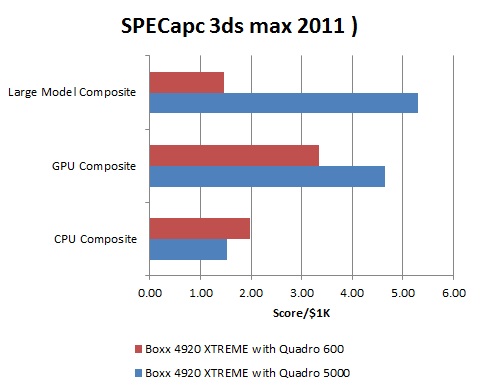
Cadalyst
The CAD space represents the largest chunk of workstation and professional graphics users. But while 3ds max gets a share of work in CAD as well as DCC, there’s one application that dominates the former space: AutoCAD. And when it comes to getting a feel for how well a card or system can handle AutoCAD, we fortunately still have the mainstay Cadalyst benchmark, now updated to 2011.
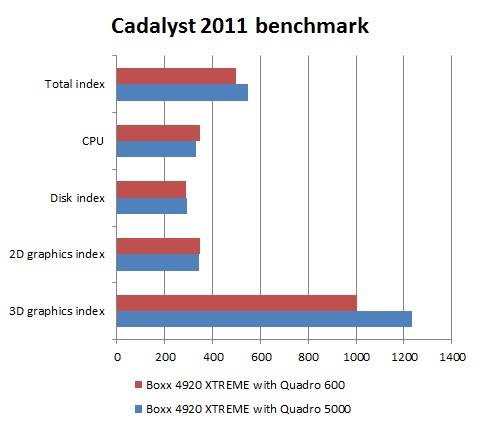
Overall the numbers lined up comparably to the Cadalyst-published benchmark numbers for Boxx’s 3980 Xtreme, a close (and also liquid-cooled) relative of our machine. Where GPUs are concerned, the results from the Cadalyst 2011 tests are on the other end of the spectrum from SPECapc for 3ds max 2011’s Large Model Composite. As is our experience with Cadalyst, performance generally scales poorly within the workstation graphics card product line (as opposed to comparing to consumer-class cards, which generally pale in comparison).
Cinebench
Last but not least, we have Cinebench. Cinebench renders a 3D sequence (currently, a car chase through town) utilizing both CPU and GPU resources. It reports a composite performance number for both CPU (CPU) and graphics (OpenGL). On both metrics, the 4920 with the Quadro 5000 once again set new high-water marks, topping other scores we’ve seen by a considerable margin. And since the OpenGL component is by definition leveraging the GPU for rendering, the Quadro 5000’s superiority clearly shows through.
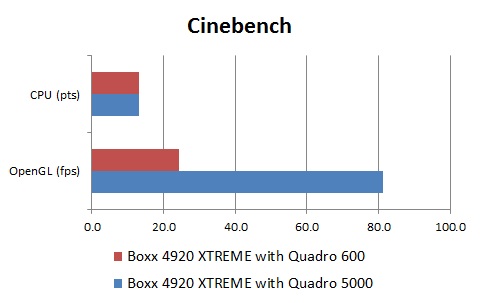
The verdict
Be the cheapest, or be the best: advice we’ve repeated many times. Lead in price, or lead in performance and innovation. And avoid that vulnerable middle ground, where you’re a little better, but not the best, or you cost a little less, but not the cheapest. Boxx can’t compete with big-volume OEMs on price, so it wisely chooses to be measured on other grounds: performance, aesthetics, features, service and dedication to the special needs of the digital media industry.
Like the 4850 Extreme before it, the 4920 Xtreme wins on those criteria. Boxx has built another winning beast of a machine, true to its charter as a highly-differentiated supplier to DCC and CAD markets.
The liquid-cooled CPU means that for many applications and tasks that don’t adequately scale with processors and cores (or at least not yet), the system wins on single-thread performance. With its stylish industrial looks, media-focused I/O and above-and-beyond support for more graphics cards than mainstream users would ever care about—but an artist or mechanical designer might demand—the 4920 clearly separates itself from the competition.
For buyers looking for the best price/performance, the 4920 Xtreme is not the best choice. But for buyers looking for the best performance at a reasonable price, in a machine that’s engineered and supported for reliability running the bread-and-butter applications for aggressive designers, it’s going to be hard to find anything better.
And from that perspective, we don’t see the Quadro 600 as a sensible complement for most potential Boxx buyers. They’re not considering shelling out the cash for the 4920 Xtreme because they want to cut corners, so compromising on the graphics isn’t the right answer for most visual-intensive applications. When it’s being paired with a liquid-cooled, top-end CPU, along with the biggest, fastest memory and storage subsystems, why risk a bottleneck on a $170 graphics card?
Alex Herrera is a senior analyst at Jon Peddie Research.





